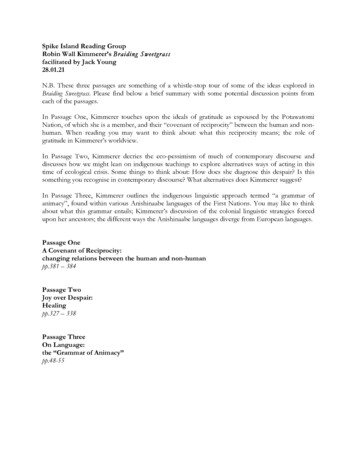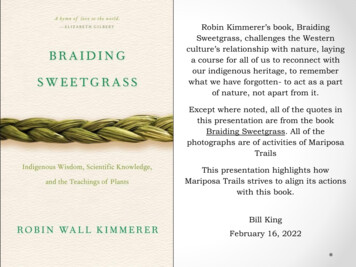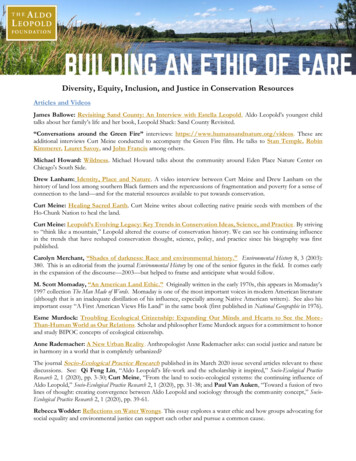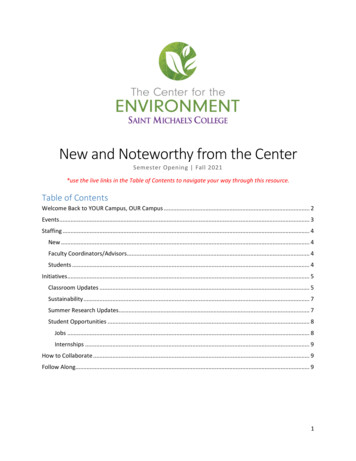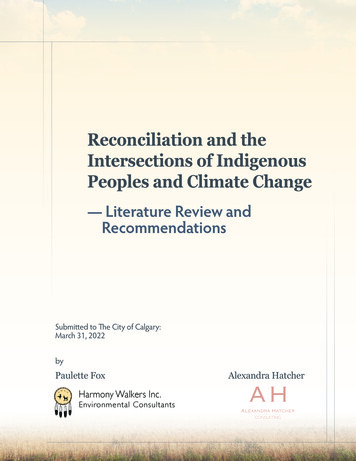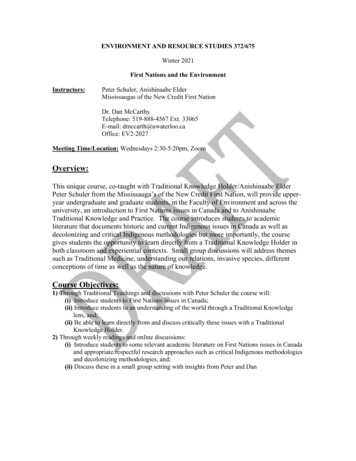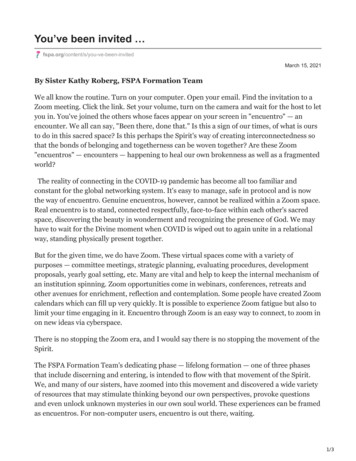
Transcription
!
Summary of “BraidingSweetgrass” by Robin WallKimmererWritten by Alyssa BurnetteWhat Native American traditions can teach us aboutlife and climate change.
Introduction5Torn Between Two Cultures6Sustainability Through Reciprocity8Practicing Sustainability the Potawatomi Way11Final Summary13
!
Introduction“Save more bees, plant more trees, clean our seas!”We see a number of motivational slogans like these on eco-friendly t-shirts.And indeed, these pithy messages are great reminders that climate changeis one of the most pressing issues of our era. Unfortunately, however, manypeople stop at wearing t-shirts that raise awareness. Having broadcastedtheir values on their clothing, many assume that they’ve done their part forsaving the planet. And sadly, many of the people who proudly wear these tshirts are the same people who don’t adjust their lifestyles to includesustainable practices. This is certainly bad, but it pales in comparison withthose who ignore climate change altogether. So, what can we do? How canwe get everyone on board and create a truly sustainable future? How can wegive our planet what it needs? To answer these questions, we will turn tothe wisdom of Native American people who have existed in harmony withnature for centuries. And over the course of this summary, we’ll explore thetoxic impact of colonization on culture and climate change to learn why weshould have listened to indigenous people a long time ago.
Torn Between Two CulturesYou might assume that the author’s research on the sustainability practicesof indigenous tribes is the result of interviews or an anthropological study.But the author is actually Native American herself! Her family is from thePotawatomi tribe. The Potawatomi are an Algonquian Native Americanpeople of the Great Plains, upper Mississippi River, and western GreatLakes region. The Potawatomi people speak their own language, also calledPotawatomi, and in their language, the name of their tribe means “people ofthe place of fire.” Like other Native American tribes, the Potawatomi have arich cultural history that has been all but destroyed through decades ofcolonization and abuse by white oppressors. In the early 1800s, they wereslowly starved off of their ancestral lands by American settlers until theyhad no choice but to give up their land and allow white colonists to settlethere.Once they had given up control, they were quickly marched out of the stateand onto reservations in a manner very similar to the notorious forcedrelocation known as the Trail of Tears. Given this painful history ofcolonization and oppression, it’s unsurprising that Potawatomi peoplewould cling to their ancestral heritage and be suspicious of white Americanculture. As a result, the author often felt that she was torn between twoworlds. She soaked up the native traditions and oral history of hergrandmother and felt compelled to honor and embrace her heritage. But asan American kid growing up in New York, she also felt tremendouspressure to “be normal” and “fit in.” While this is a difficult balance forevery child to strike, the pressure is certainly more intense for children whoare being raised in two different cultures.The author felt that the strain was especially difficult because her twocultures were polar opposites. The dichotomy was especially obvious whenit came to cultural attitudes toward food and farming. For example, herPotawatomi family taught her about the importance of gratitude,sustainability, and reciprocity. They believe that people and nature are
interconnected in a mutually beneficial relationship. So, when you are kindto the environment, you are also being kind to yourself and vice versa. Theyalso believe that human beings have a moral obligation to show gratitudefor nature’s bounty. For example, if you enjoy wild berries or grains thatyou have grown or harvested yourself, you should be kind to nature andexpress gratitude for what you have enjoyed. In practice, this might meanthat you plant a seed as a gesture of thanks or do something else thatencourages nature to flourish.Modern America, by contrast, is primarily interested in what it can take.Although we are seeing an increase in efforts to give back to nature andrespect the planet, we have an overabundance of food waste, fast fashion,and deforestation. Rather than thanking the planet for what it gives us, weare violently taking what we want and giving little in return. Having noticedthis catastrophic disparity between the values of her two worlds, the authorbegan to think critically about the values of her native people. When youcompare the two cultures, attitudes, and values, it’s certainly easy to seewhich is preferable! And that’s why Kimmerer thinks it’s time that wenormalize Native American sustainability practices.
Sustainability Through ReciprocityNow that we’ve examined some of the core values of the Potawatomi, it’stime to take a closer look at how these values would affect our lives inpractice. The author believes that a shift in our attitude toward nature andour relationship with it would be the biggest step in the right direction.Because, as you can see from the previous chapter, our entire outlook wouldbe different if we viewed ourselves as being in a mutually beneficialrelationship with nature. In this respect, our relationship with the planetwould be much like our relationship with a romantic partner or a friend. Ineither scenario, it’s widely accepted that being selfish is a bad thing. No onewants to invest in a relationship where one person takes without givinganything in return. So, if we thought of ourselves as doing that to theplanet, how would that impact our worldview? What would we stop doing?What practices would we implement instead?For example, many people think of recycling as being an extremelyenvironmentally- friendly practice. (And indeed it is!) But often, we do thebare minimum when it comes to recycling, and behave as though we expectto receive a trophy for our sacrifices and sustainability. This example showsexactly how skewed our worldview can be. Because it’s highly unlikely thatwe would condone this attitude in our relationship with another person.For example, if you gave your boyfriend a kiss or remembered his birthday,would you think, “Wow, I’m the world’s best girlfriend!” Probably not,right? Rather, you’d understand that you were doing the bare minimum(and that you should really up your game!) Instead of doing the bareminimum, you would probably think that you should do more to show thatyou love and appreciate him. And that’s exactly how we should approachour relationship with the earth.The Potawatomi understand this and they put this into practice throughmany facets of their everyday lives. One example can be seen through atradition known as “the honorable harvest.” The honorable harvest isfounded on the principle that the earth does not exist solely for human
consumption. Other animals and plants depend on nature for survival aswell. The Potawatomi believe that you must respect this balance if you wantto live in harmony with nature. So, when they grew crops, the people onlyharvested half of what they grew. That half was used to feed their families.The other half was used to feed the wild animals and plants who lived in thearea and depended on the availability of crops and fertile soil to grow. Indoing so, the Potawatomi believe that they are giving back to nature andthanking the land and other animals by acknowledging their mutuallybeneficial relationship.This practice is not mandated by the government or enforced in any way.Rather, it’s something that people do willingly, out of the goodness of theirown hearts, because it’s a value they cherish. And, having considered thisexample, the author posits that modern American society should introducesimilar practices. Although we currently have no such laws on the books,Kimmerer argues that we shouldn’t have to make this practice a legalstatute. Instead, what if we simply showed people the importance of beingkind to the planet as we are kind to one another? What if this wassomething people wanted to do?If we could orchestrate a shift in our cultural mentality and viewsustainability practices as an act of kindness, then we wouldn’t try to patourselves on the back for simple acts like recycling. And we wouldn’t wasteour time trying to legislate practices that many people wouldn’t followanyway. Instead, we would willingly engage in sustainability through asense of reciprocity. And rather than snatching resources from the earth,we could revolutionize our attitudes about what we need and what we havea right to take from nature. That’s why the author posits that the concept ofreciprocity is key to conceptualizing our relationship with nature. Bydefinition, reciprocity means “the practice of exchanging things with othersfor mutual benefit, especially privileges granted by one country ororganization to another.” And whether we think about it in those terms ornot, we already rely heavily on the concept of reciprocity in other facets ofour lives.
For example, as previously mentioned, most of our human relationships arecentered around an equal balance of give and take. We share our resources,our support, and our knowledge with others. We give freely of our time,energy, love, and friendship. When we learn something new, most of usunderstand that we should take the opportunity to enrich someone else’slife by teaching them that skill. And in return, others do the same for us. Infact, our earliest lessons about life are shaped by the concept of reciprocity.As early as pre-school, we learn that “sharing is caring.” We are taught to“do unto others as you would have them do unto you.” And from theselessons, we glean a clear message about the world: if we are kind, otherswill be kind to us. If we do the right thing, other people will do the rightthing too. We think of this when we offer someone our seat, when we holdthe door, when we say “please” or “thank you.” We think of this wheneverwe do something that we would want others to do for us. So, why can’t wethink about this when it comes to our relationship with nature?
Practicing Sustainability the Potawatomi WayIn the previous chapter, we established that a shift in our attitude is thefirst big step for implementing sustainability practices. But now it’s time totake a look at the other things we should do. The author’s actionablestrategies on this topic stem from a combination of her Potawatomiheritage and her experience as a professor of environmental biology.Throughout her career, Kimmerer has found that blending her culture andher education has proved invaluable because her heritage has enabled herto teach sustainability practices in a uniquely compelling way.Drawing on her grandmother’s teachings about reciprocity and thehonorable harvest, the author typically invites her students to truly go outand engage with nature. Rather than learning about it from a textbook, sheencourages them to get their hands dirty in her very own garden andwitness the interconnected life cycle of plants, animals, and humans forthemselves. She also blends traditional teaching methods with stories aboutindigenous agricultural practices. These stories help her to illustrate thepoint that we should concentrate on the interconnectedness of all life. Weshould plant seeds that are compatible with one another and that will growwell together. We should learn about the relationships between plants andidentify those that will naturally coexist in a harmonious, mutuallybeneficial relationship. And by allowing plants to flourish and protect eachother, we could eliminate toxic and unsustainable practices like coveringour crops in harmful pesticides.And above all, we can pass our wisdom on to the next generation. This isperhaps the most vital lesson of all because our future depends on ourchildren. No one is born with an unkind view of the earth just as no one isborn racist. We learn hatred, prejudice, and selfishness from the ignoranceof those who teach us. But what if we taught our children to be thankfulabove all else? What if we taught them to view the earth as their friend?What if we encouraged them to look after the planet and each other? If we
want the next generation to have a future, then we need to teach them togive back to the planet.
Final SummaryWhen people hear about climate change, they often scornfully dismiss it asa hoax or a divisive political issue. But the author believes that ourrelationship with the planet should be neither divisive nor political. Rather,we should take care of the earth because we want to, because weunderstand that humans and nature are inexorably intertwined. That’swhat the author learned from her Potawatomi family. They taught her totake only what she needs from the planet, to be thankful for the earth, andto give back with a grateful heart.These life lessons have not only shaped her worldview, but they haveinfluenced her career as a professor of environmental biology. And as aNative American woman and an academic, Kimmerer firmly believes thatindigenous teachings should be included in the conversation onsustainability. If we implemented Native American sustainability practicesand passed these values on to the next generation, we might truly have ashot at creating a beautiful and sustainable future for our children.
!
Summary of "Braiding Sweetgrass" by Robin Wall Kimmerer Written by Alyssa Burnette What Native American traditions can teach us about life and climate change. Introduction 5 Torn Between Two Cultures 6 Sustainability Through Reciprocity 8 Practicing Sustainability the Potawatomi Way 11
